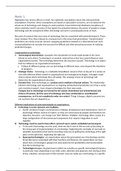Week 1.
Digitization has various effects on work. Are optimistic assumptions about this and pessimistic
assumptions. However, these assumptions are based on speculative scenarios, are not based on the
actual use of technology and changes in work practices, have limited and idealized conceptions of
what constitutes work in practice & they ignore the interplay between the power of people to shape
technology and the unexpected effect technology can have in unanticipated areas of work.
Also part of research that sees wave of technology that are associated with potential impacts. These
views mislead. First, they mislead on a factual level in the sense that generalized, “transformative”
predictions are rarely accurate. Second, sweeping predictions mislead on a theoretical level. Such
conceptualizations do not take into account the difficult and often precarious process of realizing
predicted changes.
3 approaches to technology.
1) Technological determinism. (example, the introduction of email made people in the more
distant to each other). Technology is an neutral, external force that has causal influences over
organizations/society. The technology determines the outcome (causal). Technology is an object
that has influence on organizational outcomes.
a. Critique different groups can use technology in different ways, even beyond the intentions
of designers.
2) Strategic choice. Technology is a malleable (kneedbaar) resource that can be put to a variety of
uses with different effects based on organizational and managerial strategies. Managers make
choices about which technology they will adopt. This strategic choice of technology will
determine the organizational outcomes
3) Enacted view. Sees technology as a product and a medium of human actions. The relationship
between technology and organizations is an ongoing sociotechnical production (so it has a social
and a technical aspect). Users shape technologies for their own needs.
Changes due to technology are formed by the actions (intentional and unintentional) and
choices of humans, but the uses of technology also have unintended or unanticipated
consequences, so it is not completely under our control. Things (changes, digital economy) are
not out there but are shaped by us.
Different implications of using technologies in organizations.
1) technology is social, dynamic and multiples.
a. Social= produces trough a social process of design, development and maintenance. Form of
technology reflects choices of makers, so they are constructed by people and therefore not
objective. Dynamic= can change over their lifetime. Multiple= technology often consist of a
large configuration of interconnected components that require integration to work
together.
2) Technology must be used to have effect, and such use is varied, embedded and emergent.
a. To be useful technology must be used, when we don’t look at this we end up focussing on
the wrong part of implementation of a technology. Neglecting the centrality of use leads to
simplistic assumptions that lead to investing resources at getting the technology at the right
place at the right time, neglecting the right use
b. Espoused technologies= are expectations about the generalized use of technology and the
broad discourses associated with their functions and features. the expectations we have
about how a technology is going to be used based on the possibilities and functionalities
that the technology has.
c. Technologies-in-use= situated ways in which we actually use specific technological features
in particular ways depending on our skills, tasks, attention and purposes and varying at time
of day, situation, and pressure of the moment. How we really use a technology in a specific
, situation. This is dependent on our skills, what task we are using it for, why we are using it
and this use can be different in different moments or for different tasks.
d. Productivity paradox= idea that increased investment in IT is not yet producing increased
productivity. More meaningful to look at the use of IT then the investment, because IT itself
can not increase productivity, but the use of IT can.
e. Use of technology is varied, embedded in various contexts, and consequently has a variety
of outcomes. Emergent= typically departs from expectations of the inventors, designers and
promoters. Purpose is emergent from the choices we make about the use of the
technology.
3) Use of technology can have unintended consequences.
Two rationales for organizational engagement in the digital economy.
1) internet has opened up a new marketplace for buying and selling. So engage because of choice
of managers to include digital economy in managerial and organizational strategies. Sees digital
economy from strategic choice perspective. Engaging in internetworking is a strategic choice to
enhance organizational performance
2) epochal social transformations. World is changing to a society where information and
postmodern systems will prevail. So the outside world is leading to change to engagement in digital
economy. Deterministic perspective, based on an assumed causal relationship between the
technological infrastructure of an era and the organizations, societies, and economies that result.
Nature of organizational engagement in digital economy. Ways in which internetworking have been
used change over the years. 4 modes at this stage. (1) communicating via email; (2) generating a
web presence; (3) establishing buyer-supplier transaction networks; and (4) creating real-time virtual
integration. What it means for organizations to “be on the Internet” will also evolve as new
technologies, business models, regulations, laws, and organizational processes emerge
While an enacted view recognizes that the digital economy, as a complex, emergent phenomenon, is
not precisely predictable or completely manipulable, it does not suggest that we are powerless.
Quite the contrary. By recognizing how our energies and efforts, interests and innovations, visions
and values produce the nature, form, features, and effects of this digital economy, we can see how
we might shape this phenomenon in new and effective ways.




